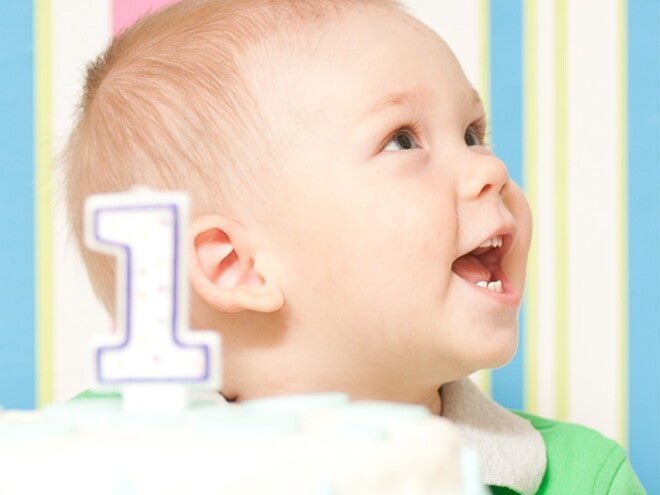
At one year
A whole year has gone by, already! Your baby is entering the realm of toddlerhood, and with this exciting milestone comes greater mobility and independence. But that doesn’t mean baby needs you any less. In fact, you’re needed more than ever.
SLEEPING ZZZZZZZZZ
daily (approx.)
12-14 hrs
1 nap; usually stops having morning naps between 1 and 2 years old. By 2 years, most children have a 1–2 hour nap after lunch.
LANGUAGE SKILLS
- Puts sounds together as though talking; understands simple requests and questions.
- Knows his name and says “mama” or “dada” with at least one other word that has meaning.
- Understands simple instructions: “Where is your shoe?”.
- Communicates a need without crying.
- Stops an action if you say “no”.
Talk to your baby more and more to build his vocabulary.
TODDLER BEHAVIOUR
Hitting, or even biting, is a normal part of learning to express frustration and anger. Be patient and help teach your toddler to say “I’m angry” or “I’m tired”.
Your baby may also kiss you on request. Keep hugging and loving him – never stop.
HUNGER CUES & FEEDING MILESTONES
- Your toddler’s appetite will vary; trust your toddler’s cues for hunger and fullness.
- Able to drink from a cup or straw; chews skilfully and efficiently.
- Rejection of new foods; expresses desire for specific foods.
- Plays with food and throws it when full.
- Appetite may decrease due to slowing down of growth.
THE CONVENIENT CHOICE
Nestlé CERELAC LITTLE 1s cereal with milk tastes yummy mummy and are so easy to make! Nestlé CERELAC LITTLE 1s cereal contains pieces and textures that will help your little one to develop good eating habits. Make mealtime yummy and fun.
All Nestlé CERELAC products already contain milk, so just add water to provide a delicious meal.
MOTOR/PHYSICAL DEVELOPMENT
- Crawls on hands and knees or scoots around on bum.
- Pulls up to standing position and stands briefly without support.
- Walks around holding onto furniture or an adult’s hand. The average age for walking alone is thirteen months.
- Walks up and down stairs with help.
- Puts objects into a container and takes them out.
- Self-feeds easily with fingers; his finger grip on small objects with his index finger and thumb is more precise.
- He starts to roll a ball, lifts a foot for a shoe and is more involved in dressing himself.
COGNITIVE DEVELOPMENT
- Can lead parent by pointing. Explores objects in different ways (shaking, banging, throwing, dropping).
- He loves an audience and will repeat actions.
- Knows the names of familiar objects.
- Responds to rhythmic music.
- Can turn a few board-book pages. Show him pictures of everyday objects and animals and tell him simple stories.
SOCIAL DEVELOPMENT
- May be shy or anxious around strangers.
- Has favourite toys and people.
- Tests limits to actions and behaviours.
- Responds to own name and comes when called.